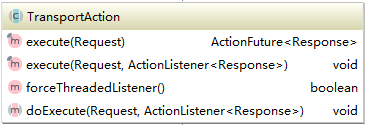elasticsearch源码分析index action
zziawan 人气:0action的作用
上一篇从结构上分析了action的,本篇将以index action为例仔分析一下action的实现方式。
再概括一下action的作用:对于每种功能(如index)action都会包括两个基本的类*action(IndexAction)和Transport*action(TransportIndexAction),前者类中会有一个实例(IndexAction INSTANCE = new IndexAction())这个实例用于client绑定对应的TransportAction(registerAction(IndexAction.INSTANCE, TransportIndexAction.class)),绑定过程发送在ActionModuel中。
另外在Action类中还会定义一个action的名字(String NAME = "indices:data/write/index")这个名字用于TransportService绑定对于的handle,用于处理NettyTransport接收到的信息。TransportAction的是最终的逻辑处理者,当接收到请求时,会首先判断本节点能否处理,如果能够处理则调用相关的方法处理得到结果返回,否则将通过NettyTransport转发该请求到对应的node进行处理。所有的Transport的结构都是这种类型。
TransportAction的类图
首先看一下TransportAction的类图,所的Transport*action都继承自于它。

它主要由两个方法execute和doExecute,execute方法有两种实现,第一种实现需要自行添加actionListener。最终的逻辑都在doExecute方法中,这个方法在各个功能模块中实现。以下是TransportIndexAction的继承关系:

实现上由于功能划分的原因,TransportIndexAction直接继承自TranspShardReplicationOperationAction,这个抽象类中的方法是所有需要操作shard副本的功能action的父,因此它的实现还包括delete,bulk等功能action。它实现了多个内部类,这些内部类用来辅助完成相关的功能。这里主要说一下OperationTransportHandler,ReplicaOperationTransportHandler及AsyncShardOperationAction三个子类。
OperationTransportHandler的代码
如下所示:
class OperationTransportHandler extends BaseTransportRequestHandler<Request> {
//继承自BaseTransportRequestHanlder
………………
@Override
public void messageReceived(final Request request, final TransportChannel channel) throws Exception {
// no need to have a threaded listener since we just send back a response
request.listenerThreaded(false);
// if we have a local operation, execute it on a thread since we don't spawn
request.operationThreaded(true);
//调用Transport的execute方法,通过channel返回结果
execute(request, new ActionListener<Response>() {
@Override
public void onResponse(Response result) {
try {
channel.sendResponse(result);
} catch (Throwable e) {
onFailure(e);
}
}
@Override
public void onFailure(Throwable e) {
try {
channel.sendResponse(e);
} catch (Throwable e1) {
logger.warn("Failed to send response for " + actionName, e1);
}
}
});
}看过NettyTransport请求发送和处理的同学一定对这个代码不陌生,这就是elasticsearch节点间处理信息的典型模式。当请求通过NettyTransport发送到本节点时会根据请求的action名称找到对应的handler,使用对应的handler来处理该请求。这个handler就对应着“indices:data/write/index”,可以看到它调用execute方法来处理。它的注册时在TransportShardReplicationOperationAction构造函数中完成的。
知道了OperationTransportHandler,ReplicaOperationTransportHandler就好理解了它的实现方式跟前者完全一样,对应的action名称加了一个“[r]”,它的作用是处理需要在副本上进行的操作,代码如下所示:
class ReplicaOperationTransportHandler extends BaseTransportRequestHandler<ReplicaOperationRequest> {
……………………
@Override
public void messageReceived(final ReplicaOperationRequest request, final TransportChannel channel) throws Exception {
try {
shardOperationOnReplica(request);
} catch (Throwable t) {
failReplicaIfNeeded(request.shardId.getIndex(), request.shardId.id(), t);
throw t;
}
channel.sendResponse(TransportResponse.Empty.INSTANCE);
}
}可以看到代码结构非常像,只是调用了副本操作的方法shardOperationOnReplica,这个方法在这TransportShardReplicationOperationAction中是抽象的,它的实现在各个子类中,例如deleteaction中实现了对于delete请求如何在副本上处理。
分析完这两个handle是不是对于action的处理过程有了一定的眉目了呢?但是这才是冰山一角,这两个Handler是用来接收来自其它节点的请求,如果请求的正好是本节点该如何处理呢?这些逻辑都在AsyncShardOperationAction类中。首先看一下它的内部结构:

因为TransportShardReplicationOperationAction的所有子类都是对索引的修改,会引起数据不一致,因此它的操作流程都是现在primaryShard上操作然后是Replicashard上操作。代码如下所示:
protected void doStart() throws ElasticsearchException {
try {
//检查是否有阻塞
ClusterBlockException blockException = checkGlobalBlock(observer.observedState());
if (blockException != null) {
if (blockException.retryable()) {
logger.trace("cluster is blocked ({}), scheduling a retry", blockException.getMessage());
retry(blockException);
return;
} else {
throw blockException;
}
}
//检测是否是创建索引
if (resolveIndex()) {
internalRequest.concreteIndex(observer.observedState().metaData().concreteSingleIndex(internalRequest.request().index(), internalRequest.request().indicesOptions()));
} else {
internalRequest.concreteIndex(internalRequest.request().index());
}
// check if we need to execute, and if not, return
if (!resolveRequest(observer.observedState(), internalRequest, listener)) {
return;
}
//再次检测是否有阻塞
blockException = checkRequestBlock(observer.observedState(), internalRequest);
if (blockException != null) {
if (blockException.retryable()) {
logger.trace("cluster is blocked ({}), scheduling a retry", blockException.getMessage());
retry(blockException);
return;
} else {
throw blockException;
}
}
shardIt = shards(observer.observedState(), internalRequest);
} catch (Throwable e) {
listener.onFailure(e);
return;
}
//查找primaryShard
boolean foundPrimary = false;
ShardRouting shardX;
while ((shardX = shardIt.nextOrNull()) != null) {
final ShardRouting shard = shardX;
// we only deal with primary shardIt here...
if (!shard.primary()) {
continue;
}
if (!shard.active() || !observer.observedState().nodes().nodeExists(shard.currentNodeId())) {
logger.trace("primary shard [{}] is not yet active or we do not know the node it is assigned to [{}], scheduling a retry.", shard.shardId(), shard.currentNodeId());
retryBecauseUnavailable(shardIt.shardId(), "Primary shard is not active or isn't assigned to a known node.");
return;
}
if (!primaryOperationStarted.compareAndSet(false, true)) {
return;
}
foundPrimary = true;
//primaryShard就在本地,直接进行相关操作
if (shard.currentNodeId().equals(observer.observedState().nodes().localNodeId())) {
try {
if (internalRequest.request().operationThreaded()) {
internalRequest.request().beforeLocalFork();
threadPool.executor(executor).execute(new Runnable() {
@Override
public void run() {
try {
performOnPrimary(shard.id(), shard);
} catch (Throwable t) {
listener.onFailure(t);
}
}
});
} else {
performOnPrimary(shard.id(), shard);
}
} catch (Throwable t) {
listener.onFailure(t);
}
} else {//primaryShard在其它节点上,将请求通过truansport发送到对应的节点。
DiscoveryNode node = observer.observedState().nodes().get(shard.currentNodeId());
transportService.sendRequest(node, actionName, internalRequest.request(), transportOptions, new BaseTransportResponseHandler<Response>() {
@Override
public Response newInstance() {
return newResponseInstance();
}
@Override
public String executor() {
return ThreadPool.Names.SAME;
}
@Override
public void handleResponse(Response response) {
listener.onResponse(response);
}
@Override
public void handleException(TransportException exp) {
// if we got disconnected from the node, or the node / shard is not in the right state (being closed)
if (exp.unwrapCause() instanceof ConnectTransportException || exp.unwrapCause() instanceof NodeClosedException ||
retryPrimaryException(exp)) {
primaryOperationStarted.set(false);
internalRequest.request().setCanHaveDuplicates();
// we already marked it as started when we executed it (removed the listener) so pass false
// to re-add to the cluster listener
logger.trace("received an error from node the primary was assigned to ({}), scheduling a retry", exp.getMessage());
retry(exp);
} else {
listener.onFailure(exp);
}
}
});
}
break;
}
………………
}这就是对应请求的处理过程。
primary操作的方法
void performOnPrimary(int primaryShardId, final ShardRouting shard) {
……
PrimaryResponse<Response, ReplicaRequest> response = shardOperationOnPrimary(clusterState, new PrimaryOperationRequest(primaryShardId, internalRequest.concreteIndex(), internalRequest.request()));
performReplicas(response);
…………
}加载全部内容